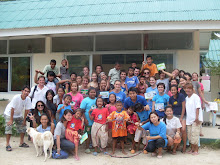
 After spending three days in Chumphon we traveled inland to Din Dang, a fledgling earth building project, as well as to a nearby watershed. There we learned about permaculture and green-building. A local named Bow had initiated the program focusing on clay building, including houses that require few outside materials not available on site. These houses could last hundreds of years, yet can cost as little as a few hundred dollars to make. Although we only got to spend two days as a group working with Bow, doing further work at Din Dang is a possibility later in the program as part of the final research project. Bow's project works in association with Runs n' Roses, a restaurant/guesthouse that generates its profits to support the Thai Child Development Foundation.
After spending three days in Chumphon we traveled inland to Din Dang, a fledgling earth building project, as well as to a nearby watershed. There we learned about permaculture and green-building. A local named Bow had initiated the program focusing on clay building, including houses that require few outside materials not available on site. These houses could last hundreds of years, yet can cost as little as a few hundred dollars to make. Although we only got to spend two days as a group working with Bow, doing further work at Din Dang is a possibility later in the program as part of the final research project. Bow's project works in association with Runs n' Roses, a restaurant/guesthouse that generates its profits to support the Thai Child Development Foundation. 
The Dindang Natural Building Center aims to promote the natural and traditional techniques of clay house building in the area of Phato in southern Thailand. The organization was set up in the year 2007 and works with both Thai and international volunteers in order to realize its current goal: to set up an educational center where all those interested in natural building techniques can find information and share knowledge.

Hi, I am Bow, (with the yellow shirt). My full name is Rawat Thongbunchu. Here is picture with my family from the concert night! We are looking forward to welcome you, living and working with us.
DinDang is my dream and I would like to share this dream with all of you. If you want to know more about the projects and ideas that I have, you can sent an email to: rawat_tongbooncho@hotmail.com
And if you like to be a volunteer with DinDang, please email to; dindang.info@gmail.com (subject: DinDang).
We hope to hear from you!!


Blog Post Enhancement by Natalie Hein:
ReplyDeleteFor those unsure of what Permaculture really is,Permaculture is an approach to designing human settlements and perennial agricultural systems that mimic the relationships found in the natural ecologies. This is exactly what we did at Din Dang.
Most modern homes and structures fight the ecology surrounding them: forcing tons of cement and rebar foundations upon the natural earth in order to create a semi-permanent dwelling. I won't go into the horrors of traditional building, but rather the pros of Permaculture or "earth building".
Before we began our hands-on experience with Permaculture, we split into groups to brainstorm the possible building materials, costs, and potential locations of a natural, earth-built house. We concluded that earth building can be done most anywhere and can be used for a multitude of functions (a traditional house, a play structure, a church, a school, etc...), can be built with any native materials (stones, twigs, hay, grass, mud, or in Din Dang's case, red earth), and costs far less than a traditional structure. Thus, we discovered that earth building is both economically sustainable and ecologically sustainable. Without introducing toxic and foreign building materials to a natural ecosystem, one doesn't face problems of contaminated water runoff, and one doesn't have to depend on industrial systems in order to create their own shelter.
This idea of self sufficiency in home building also categorized Permaculture as socially sustainable. In impoverished areas such as rural southern Thailand, shelter is necessary, but can be costly and can enslave the inhabitants to expensive rent and debt. With Permaculture, once intended inhabitants learn how to construct such a structure (easily, as we found out through experience) they can cheaply and rapidly put together a house for themselves that can last for years and takes little to no industrial energy output and high resource cost. One of Din Dang's aims is to pass on the knowledge of earth building to those for whom it may be beneficial (potentially the whole world?).
After our brainstorming session we got outside and got dirty. We hopped into a pool of red mud and, with our feet, churned until the mud was of a smooth consistency. We then heaped the clay into simple wooden, rectangular molds to make bricks. We made about 90 in a short period of time (maybe 2 hours). The process was one of the most fun experiences of the whole trip, and was, for me, one of the most applicable to my future work. As an architecture student, I can easily apply what I learned about permaculture from Din Dang to my future projects.
The whole experience got me thinking about all of the functions permaculture can have in a developed society like the US, even if we, the privileged, don't want to live in a mud house. Every year, thousands of families invest in plastic play houses or dog houses. Instead of wasting financial resources on a toxic playhouse, why don't families get together for a weekend project and build a playhouse out of dirt, sand, or mud? The same can be said for a dog house, an outdoor patio, or a bench. The process is a blast and the outcome is priceless.
If we can learn to use permaculture, we'll find ourselves more financial stable, more self sufficient, and far more ecologically sustainable. What could be better than that?